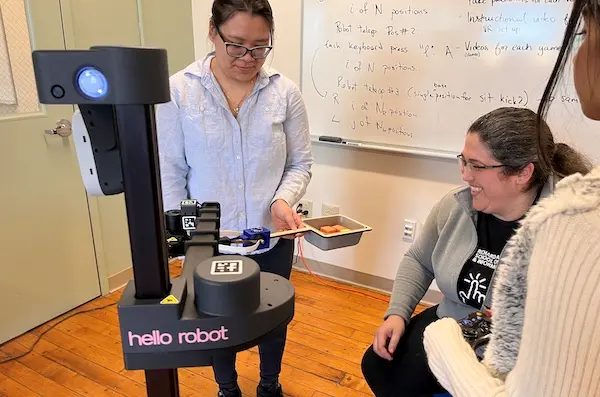
Computer science major ThienTran Le and Asst. Prof. Maru Cabrera test the robots movements.
About 10,000 babies born each year will develop cerebral palsy (CP), making it the most common physical disability of childhood. Children with the condition may struggle with sitting, reaching, walking and climbing stairs, due to irregular movements and stiff muscles.
Physical therapy exercise training can help kids improve strength, balance, aerobic capacity and flexibility, helping children perform everyday movements such as sitting and standing.
There is one problem, though.
“The challenge is that some children find PT exercises repetitive, difficult or just boring, so they stop doing them,” says Assoc. Prof. of Physical Therapy and Kinesiology Maggie O’Neil. “In addition, kids and their families may have limited access to PT services due to limited health benefits or living in an area with limited services.”
In a new study funded by an internal seed grant, O’Neil and Computer Science Asst. Prof. Maru Cabrera have combined their expertise to find a solution. They are evaluating whether virtual reality (VR) gaming and a roving robot can improve the mobility of a group of children with cerebral palsy and keep them engaged. The study begins this spring in the Health Assessment Lab on South Campus.

Exercise science graduate Andrew Gaskins demonstrates the virtual reality game with Assoc. Prof. Maggie O'Neil viewing the game on a screen.
During the study, the children, ages 8 to 12, will play three therapeutic games in three different conditions: VR games, VR games with haptic vibration that simulates a sense of touch, and robotic games. The movements that the children do in the games align with PT exercises they do in clinical settings. The VR game activities were developed by O’Neil; Cabrera and her computer science students developed the haptic vibration and robotic games. The team includes a game designer who worked with O’Neil to create the VR games.
“We will record motion data in all game conditions and learn from the kids if the technologies help to motivate them to keep moving,” says O’Neil, who has extensive clinical and research experience with promoting health, functional mobility and physical activity in youth with CP.
In the VR games, the children will don headsets to be immersed in a 3D world. The headset tracks head movement, sensors on the wrists and ankles track arm and leg movements, and a device worn on their backs tracks their trunk movements. O’Neil is able to adjust the distance at which a series of objects appear for each player. In one game, kids reach to grab and drag a balloon to a pin to pop it. In the VR haptic games, they will feel a vibration when they pop the balloon and see graffiti.
“We will test the use of different assistive technologies like haptics to see if the children’s movements improve and if they are more motivated to continue,” says Cabrera, who researches assistive technology, robotics and gesture recognition for people with disabilities.
In the game with the robot, the kids will wear wrist, ankle and back trackers and will reach to drop foam blocks into a basket that is being moved around by the robot.
Andrew Gaskins ’23, who recently completed the exercise science program, is working with O’Neil as a research assistant, confirming the clinical data measurement protocols and conducting VR game testing. During the study, he will guide the participants and their parents or guardians throughout VR or robot gameplay. “So far, I have gained a lot of wisdom in how health care research works, especially behind the scenes,” says Gaskins, who recently got accepted into physician’s assistant school.

Computer science major Jiya Panchal programmed the movements of the robot.
Computer science major ThienTran Le ’24, who is interested in research as a possible career, jumped at the chance to work on the project with Cabrera. When testing starts, Le will make sure that the robot games work smoothly and properly.
“I wanted to actively make a positive impact, so this opportunity to help kids improve function came at the perfect time,” says Le. “I've been able to apply a lot of my knowledge from my current classes in software development and engineering to the project. It has definitely opened my eyes to the world of robotics.”
Jiya Panchal, a sophomore computer science major, is programming the robot's movements.
“I was very excited to work on a project that directly impacts children with cerebral palsy,” says Panchal. “I am gaining so much experience by working on this project that I’ll be able to apply to my future career. I couldn't be more grateful to Dr. Cabrera and the team for allowing me such an experience.”
If the research shows that the children improve mobility, the next step would be to expand the study.
“I can see these technologies being used in a PT clinic and even possibly at home to provide children with greater access to care,” says O’Neil.
